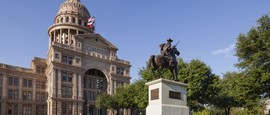Austin History
After Texas won independence from Mexico in 1835-1836, the newly formed Texas Congress decided to use Austin as its new capital, having named it after Stephen F. Austin, the man affectionately known as The Father of Texas. Stephen F.
Austin is famous for having established the first colonies in the region.
Between its settlement and the year the State Capitol was built in 1888, Austin witnessed the ebb and flow of its residents, due to the recession of Congress and fighting within the Texas government. By the late 1800s, Austin was back on its feet and in 1891 was one of the first American cities to utilize a vast street light system known as the Moonlight Towers. Several of these towers still exist and can be seen illuminating parts of the city.
By the early 1900s, Austin was left in the shadow of big oil towns like Houston and Dallas. It wasn’t until the 1960s and 70s with its embracement of arts and culture, that Austin started to really show up on the map. The city developed big music venues like the Armadillo World Headquarters, Hole in the Wall, Continental Club, Liberty Lunch and Antone’s attracting musicians like Janis Joplin, Willie Nelson and Stevie Ray Vaughan.
Technology is also a big aspect of the city. Tech companies such as Dell, AMD, and Texas Instruments are located in the city, and Google, Facebook and Apple also have secondary offices here. With the influx of ambitious young people to the area, many startups and apps have been conceived in the city.
Weather is also an important part of Austin history. Austin has seen devastating floods over the years, with the most recent damaging floods being in 2013 and 1981.
What once started out as a sleepy town with a population of 22,000 in 1900 is now the 11th largest city in America with over 842,000 inhabitants in the city proper and over 1.8 million in the metro area.
Did you know?
• In 2011, Texas saw its worst fire on record in the Austin suburb of Bastrop. Over 1,600 homes were destroyed after a record-breaking drought.
• About 1.5 million bats live under the Congress Avenue Bridge between March and November, making it the largest urban bat colony in North America.
• Texas State Capitol building is America's largest state capitol building with the dome looming seven feet higher than the Capitol in Washington D.C.
Do you have any Feedback about this page?
© 2025 Columbus Travel Media Ltd. All rights reserved. No part of this site may be reproduced without our written permission, click here for information on Columbus Content Solutions.




 You know where
You know where